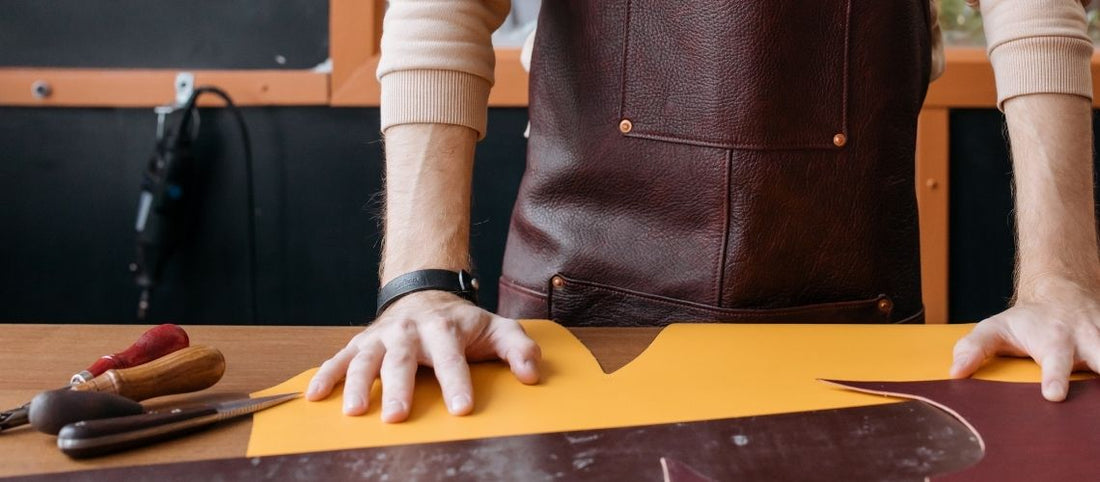Can I Attach UV DTF Sticker to Leather Jacket?

Yes—you can absolutely attach a UV DTF sticker to a leather jacket and with the right steps, the results are both durable and eye-catching. UV DTF printing provides a detailed and vibrant decal that adheres well to smooth and clean surfaces, including real and synthetic leather. Proper surface preparation, careful application and mindful aftercare ensure the sticker stays firmly in place without peeling or cracking.
Leather as a Surface
Leather (whether real or synthetic) has a somewhat tricky surface for stickers and decals. Genuine leather comes from animal hides, so it may include natural oils, subtle texture differences and an occasional wax or protective coating. These elements can interfere with some adhesives, making it essential to prepare the surface before applying anything that must stick permanently. Faux leather, often made of polyurethane (PU) or polyvinyl chloride (PVC), tends to have a more uniform texture and fewer natural oils. This can actually make it easier for adhesives to bond to synthetic leather—provided you avoid overly high heat settings that might cause the plastic to melt or warp.
Real leather has pores and may be finished with conditioners or oils. These oils can rise to the surface, making it difficult for a sticker to grab on firmly. Genuine leather can also vary in thickness and texture, so different parts of a single jacket might have slightly different surfaces. Faux leather typically has a more consistent texture, but it can be sensitive to heat; pressing it at too high a temperature can cause it to bubble, distort or discolor. In any case, gentle preparation (cleaning, drying and possibly lightly scuffing if the finish is very glossy) is critical for successful adhesion.
Because leather can flex when worn, any decoration must be flexible enough not to crack or peel during normal movement. This is one area where UV DTF excels, as long as it's carefully formulated. When the UV ink cures, the resulting layer is somewhat flexible. If you place it in an area with moderate bending (like the back or upper chest of a jacket), it can last many years without cracking.
Adhesion and Durability
When carefully applied, a UV DTF decal will adhere strongly to leather. The adhesive layer is designed to bond permanently, forming a robust seal as the design cools and sets. Many users note that once a UV DTF sticker is placed onto a prepared leather surface, it resists typical wear like rubbing or minor scuffing.
UV-cured inks themselves are well-known for their toughness: they typically won't wash off with water and they resist general abrasion. This is why direct UV printing is favored in industrial applications where prints must be resilient. By transferring that ink layer to leather through DTF, you get a final product that retains many of these protective properties. Water droplets, for instance, can be wiped away without smudging the design. Furthermore, UV-curable inks are generally more fade-resistant than standard inks, though any print—no matter how durable—can fade over time with excessive sun exposure or harsh conditions.
The average life expectancy of a UV DTF graphic on leather can be several years, assuming normal use. A jacket typically isn't washed in a machine, so it avoids the intense friction and water saturation that cause problems for decorated fabrics like T-shirts. Occasional cleaning with a gentle cloth won't harm the print and everyday wear should be no issue as long as the sticker isn't placed over an area that constantly creases or folds. Even so, higher-end UV DTF films are formulated to be flexible, so moderate bending shouldn't cause cracks.
Factors that can change how long your design lasts include:
- How thoroughly you prepped the leather (residues can weaken adhesion).
- The overall quality of the UV DTF film and inks.
- Whether the jacket is exposed to extreme conditions (e.g., very high heat, direct harsh sunlight for prolonged periods or chemicals that degrade adhesive).
- Whether you used an optional clear sealer or protective coat on top of the design.
With good practices, UV DTF can deliver vibrant visuals that last as long as the leather stays in good shape. The decal often outlasts cheaper forms of decoration like generic stickers or low-end iron-ons.
Application Process
Attaching a UV DTF sticker to your leather jacket is typically a hassle-free process, but it helps to follow each step carefully. Below is a straightforward procedure that maximizes the chances of the sticker bonding well:
Clean and Prepare the Leather
Gently wipe the jacket with a clean cloth to remove any loose dirt or dust. If the leather is quite dirty or has visible oils or residue, use a small amount of isopropyl alcohol on a soft cloth or a designated leather cleaner. The goal is to cut anything that might interfere with adhesion. Allow the surface to dry completely before moving on. Ensure you do not soak the leather—it needs only a light cleaning.
Position the Sticker
Decide where you want the design to go. Take your time to line it up carefully. You can place the sticker (while it's still on its carrier sheet) over the jacket to visualize the layout. For a large piece, tape the edges of the film to keep it from moving as you apply heat or pressure. Double-check alignment and orientation so you're certain everything looks right before bonding.
Apply Heat or Pressure (Depending on Your Sticker's Instructions)
Some UV DTF stickers are heat-activated, while others just need firm pressure. If heat is needed, set your heat press or household iron to a low-to-medium temperature that's safe for leather. A pressing time of around 10–20 seconds is often enough, but follow the instructions from your sticker manufacturer if available. Place a Teflon sheet or parchment paper over the sticker to protect both the leather and the transfer, then press down evenly. If no heat is needed, use a roller or squeegee to burnish the sticker onto the leather with firm pressure.
Peel the Film
Once you've pressed or burnished the sticker adequately, let the area cool for a few seconds if you used heat. Then slowly peel away the carrier film, starting at one corner. If any part of the decal lifts off the leather, lay it back down and apply a bit more heat or pressure. The finished result should be the ink layer bonded directly to the leather.
Optional Sealing
To further protect the design, you can apply a thin layer of a leather-safe clear finish or sealant. Make sure the sealer you choose is compatible with the UV DTF material and the type of leather you have. This extra coat helps guard the decal's edges against peeling and can provide more UV protection. Let everything dry fully before wearing the jacket.
Allow Curing Time
Leaving the jacket undisturbed for a few hours is wise. This gives the adhesive ample time to lock in, which helps reduce any chance of lifting at the edges. Avoid bending or folding the area where the sticker is applied right away.
Challenges and Solutions
Although UV DTF stickers generally adhere well to leather, there are a few challenges to keep in mind:
Peeling or Lifting Edges: If the sticker peels, it's often because the surface wasn't thoroughly cleaned or was still slightly greasy. High-quality adhesives also matter—lower-grade UV DTF materials may not stick as firmly. A quick fix is re-pressing the lifted edge with a bit more heat or a dab of compatible glue, though prevention (proper cleaning and using quality materials) is the best strategy.
Cracking Over Time: Leather bends when worn, especially in areas like elbows. An overly rigid decal might eventually crack if it's subjected to frequent folding. Using a flexible UV DTF film and placing your design in a less crease-prone area helps. Proper heat settings also matter: overheating the decal can make it brittle.
Fading: While UV DTF inks resist fading better than many alternatives, consistent exposure to harsh sunlight can still dull colors over the years. Storing the jacket away from direct sun when not worn helps preserve both the leather and the print. Some people add a clear UV-protective coating over the design for extra assurance.
Overheating Synthetic Leather: Faux leather (PU, PVC) can warp if pressed at too high a temperature. A moderate heat setting and a protective barrier (like a Teflon sheet) helps avoid damage. If you're in doubt, test a small scrap of the faux leather or an inconspicuous part of the jacket before committing to a large area.
Alternatives to UV DTF Stickers for Leather
UV DTF isn't the only way to decorate leather, though it offers a strong combination of detail, durability and relatively simple application. Depending on your artistic vision, resources and budget, you might also consider these methods:
Heat Transfer Vinyl (HTV): Popular for fabrics, HTV can sometimes collaborate on leather if the bonding temperatures are carefully controlled. However, it may be less flexible over time and prone to peeling if the leather's texture or finish doesn't cooperate. It's also more challenging to achieve intricate color blending with HTV.
Screen Printing: Screen printing uses specialized inks pushed through a mesh stencil onto the leather's surface. It can yield excellent results for bold, simple designs or large-scale text, especially for mass production. However, doing fine detail might need multiple screens and skillful layering. Screen printing on leather also demands inks that stay flexible.
Embroidery or Patches: Sewing a design directly onto leather or attaching embroidered patches adds a classic, handcrafted look. Patches in particular are popular with biker and fashion jackets. The drawback is the difficulty of sewing through thick leather, often needing heavy-duty machines or special needles. There's also no easy way to remove embroidered elements without leaving holes.
Hand-Painting: Artists can create one-of-a-kind pieces by painting leather using acrylic leather paints or similar mediums. This approach offers absolute creative freedom—anything from simple lettering to photorealistic art is possible. Proper sealing is critical and painting can be time-consuming, especially if you want multiple layers or complex details. If you're after a unique, personalized piece and have the patience, hand-painting can be extremely rewarding.
Maintenance and Care of Your Customized Leather Jacket
Keeping a UV DTF design looking sharp on a leather jacket mostly comes down to common-sense leather care. Because the inks and adhesive are robust, you don't need elaborate precautions. Still, a few tips help prolong both the life of the decal and the jacket itself:
Gentle Cleaning: If you notice dust or mild dirt, wipe the jacket with a soft, damp cloth. For tougher grime, use a leather-specific cleaner sparingly. Avoid scrubbing aggressively or using harsh chemicals, which can degrade the adhesive or damage the leather's finish.
Condition the Leather (Not the Sticker): Leather receives help from occasional conditioning to stay supple. Use a product designed for leather and avoid applying it directly on the printed design. Conditioners can contain oils or waxes that interfere with the decal surface. Instead, condition around it or carefully collaborate around the edges.
Limit Extreme Heat and Sunlight: High temperatures can potentially soften or weaken adhesives. Avoid leaving your jacket in a hot car or near a radiator for extended periods. Sunlight can also fade both leather dye and prints, so storing your jacket in a shaded spot helps. Wearing it in sunshine during normal use is fine; just don't let it bake under direct UV rays for days on end.
Minimize Abrasion: While UV DTF prints hold up well to everyday wear, excessive friction—like wearing a backpack that constantly rubs against the design—could shorten its lifespan. If possible, shift shoulder straps to avoid scuffing the decal or at least be mindful of how it's rubbing.
Proper Storage: Hang your jacket on a sturdy hanger (preferably padded) in a cool, dry place. Try not to fold it, especially through the area where the decal is attached. Prolonged creasing can stress the design.
Expert Insights and Real-World Use Cases
People involved in both commercial printing and leather crafts often highlight how well UV DTF attaches to leather. Shops that previously relied on screen printing or embroidery for custom leather apparel have adopted UV DTF transfers for complex or photo-quality designs. Hobbyists and DIY enthusiasts also appreciate that they can create small runs or one-off pieces without needing large-scale screen printing setups or paintbrush skills.
Real-world users have reported success on jackets, leather phone cases, belts and purses. The level of detail achieved is appealing for those who want intricate art—like band logos with shading, illustrations with multiple colors or even photographic images. One advantage is that the process avoids thick layers that might crack. A well-made UV DTF film, once adhered, feels relatively thin and conforms to the leather's texture.
From a cost perspective, UV DTF can be more affordable than either outsourcing screen printing (especially for a small number of items) or paying for complex embroidery. It also gives a different aesthetic than embroidered patches; some people love the thread-based look, while others prefer the sleek feel of a decal that becomes almost part of the material. For a statement piece on the back of a leather jacket, UV DTF is often favored because it can reproduce detailed artwork at a larger size without the layered buildup you might get with other methods.
In terms of durability, anecdotal reports show that UV DTF prints on leather stay intact through moderate exposure to rain or moisture, regular wiping and occasional scuffing. Users who ride motorcycles with a leather jacket that includes a UV DTF design often share that even with wind and some road debris, the print stays bright. Of course, extreme abrasion (like a serious fall) or persistent friction can damage any surface, but day-to-day wear typically doesn't pose a problem.

